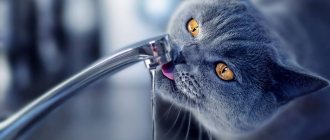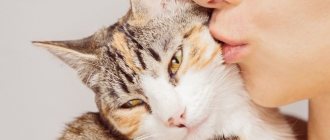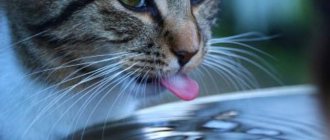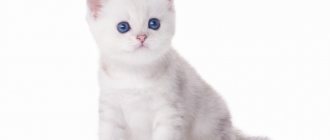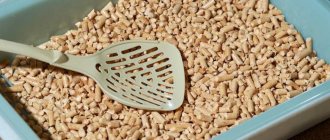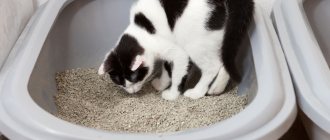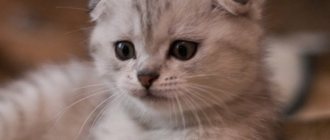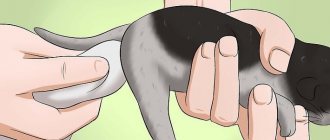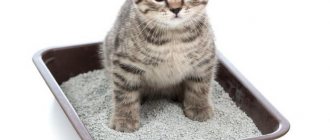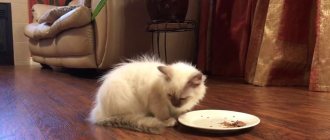Author: Olga
When planning to get a cat, some people strive to buy a baby who is not yet three weeks old. And this is the main mistake, because without knowing when kittens start eating on their own, you can simply kill the baby. We invite you to get acquainted with the small world of kittens to understand what you can feed them and when you need to start changing their diet.
[Hide]
How to raise kittens correctly
The eighth, ninth, tenth, etc. appeared in your house. wonders of the world - kittens . How to raise them correctly so that boys are real gentlemen and girls are noble maidens? First of all, you need to take care of their mother: feed her carefully, constantly pet her and allow her to do everything except destroy the apartment or house. Then she will “gladly” give birth to beautiful and healthy kittens for you, and will always wash them, feed them and take care of them. The kittens are almost a month old, they already want to jump, run and have fun. If you have them in a certain fenced area, then you can start releasing them “into the wild”, let them run around the house.
A few necessary recommendations
It is difficult for your kitten to feed himself if the dishes are awkward or large, so you should choose dishes that are the right size and that are stable on the floor. This way the baby will feel more comfortable and will eat more willingly.
Don't forget the following simple rules:
- A saucer of water should be placed near the bowl of food.
- You cannot force a kitten to eat.
- Do not mix dry food with regular food. This can only be done when switching from one food to another.
On a note! The kitten will refuse food that is too hot or, on the contrary, cold . Food should be at room temperature.
If the kitten is left without taking into account the cat's concerns
If a kitten is raised by an adult cat, then it becomes independent in the blink of an eye. For about two months, kittens feed on their mother’s milk, so if their development and adaptation occurs confidently, the cat will wean the kittens off milk much earlier. At the age of 3-4 months, kittens are able to eat independently, separately from their mother.
Normally, kittens can breed a cat for up to 6-8 weeks, and in this case it sounds like you should keep an eye on the cat herself. She must receive proper sleep and rest so that all kittens have enough milk, and it does not lose its beneficial properties. If a cat does not receive what it needs, it quickly becomes exhausted and can get sick. At such moments, the cat’s parental instinct kicks in, and the instinct of self-preservation fades into the background. The cat needs to be taken away from the kittens for a while, its nutrition monitored, vitamins added to its food, or calcium injections given.
There are cases when kittens are left without maternal care, and all responsibility and care for them falls on the shoulders of the owner. In order for a kitten to feel comfortable, it needs not only food, but also care, care and affection. He should arrange a warm and comfortable home; this could be a private house or a box covered with soft fabric. As soon as he feels safe, he will be happy to sit still.
Cat's milk can be replaced with cow's milk, previously heated to 37 degrees. Until the kitten is 2 weeks old, it needs to be fed 8 times a day; a regular medical pipette will make the feeding process more convenient for both the owner and the animal. The pipette can be replaced with a special small bottle with a nipple, which can be purchased at a veterinary pharmacy. When a kitten is hungry, this is easy to recognize; it will squeak and poke its nose in search of seed.
Why doesn't the kitten drink water?
Here are the main reasons why a pet refuses fluids.
All kittens must drink water
Age
If an animal is raised by a cat, then she will teach the cub all the necessary skills by personal example. Small kittens recently weaned from their mother's milk do not know how to lap. The owners will have to independently accustom them to the bowl and tray. Therefore, it is recommended to take your pet into your home when it is over 2.5 months old.
For your information! Sometimes the kitten does not drink fluids during the period of changing baby teeth. This occurs at 3-5 months. A loose tooth causes discomfort and pain, which provokes a reluctance to drink and eat from a saucer.
Dirty bowl
Cats are tidy animals, so they do not tolerate dirty dishes well. The animal will not lap from a bowl that is in an inappropriate place, near the toilet, poorly washed or smells unpleasant. This forces him to look for a source of moisture elsewhere. For example, a kitten can happily lap from a puddle, vase, aquarium or tap.
You need to watch your pet; perhaps he has chosen a source of liquid in another place. Some kittens adapt to licking drops from the sink, a damp bathroom curtain, or from a freely accessible jar.
Disgusted kittens will never lap from a bowl that stands next to the food. They believe that the water in it cannot be clean. Animals often refuse liquid if the drinking bowl is in a noisy place. They instinctively sense anxiety and danger.
Sometimes a cat is scared off by the smells of chlorine and iron that come from tap water. What is recommended to feed a kitten? The solution is to use filtered or settled liquid. The best option is to use bottled water. Some cats only drink running water. They instinctively feel that it contains more oxygen. In this case, the owners will have to fork out money and install filters on the taps.
Important! The drinking bowl should be cleaned with clean water and baby soap. Dishwashing detergents have a specific smell that repels the animal.
Bright color bowl
Cats love when their drinking container has a natural color. Bright colors repel the animal, and it refuses to drink liquid. The solution would be a ceramic drinking bowl of a neutral color; moreover, such a vessel does not absorb unpleasant odors and is easy to clean.
Disease
Just yesterday, an active kitten drinks little water today, what to do in this case? It is important to pay attention to its general condition. If the animal becomes lethargic, apathetic, and refuses not only to drink, but also to eat, this indicates the presence of health problems.
A kitten may refuse fluids if the following diseases develop:
- rabies is an infection that occurs in unvaccinated animals. Pets living in a private home or interacting with rodents become infected. One of the symptoms of the disease is a complete refusal of water. There are other signs: unusual behavior, apathy, aggressiveness, change in voice. The young animal dies within 5-7 days;
- viral peritonitis develops in cats older than 10 months. Infection occurs orally through consumption of food or contact with a sick animal. Manifested by fever, refusal to drink, abdominal enlargement, shortness of breath;
- Toxoplasmosis is a common disease in the cat family. Infection occurs through consumption of raw meat, contact with sick animals and rodents. Almost all sandboxes standing outside are infected with toxoplasma. If your pet has free access to them, the likelihood of infection is very high. Toxoplasmosis is manifested by fever, shortness of breath, diarrhea, discharge from the eyes and nose, and refusal to drink.
A kitten may refuse water if there is inflammation on the tongue and gums, and it becomes painful for him to swallow.
Bloating in a kitten is a sign of illness.
If symptoms such as vomiting, diarrhea, sunken eyes, a very enlarged abdomen, or fever appear, you should immediately contact a veterinarian. Rapidly developing dehydration can lead to the death of a cat.
How to train a kitten to lap milk or water?
If even then they do not drink, then simply leave the milk in a visible place, and, feeling thirsty, the kittens will run to drink.
Once the kittens have learned to go to the toilet, drink milk and behave relatively well, it is time to part with them. It’s best if you have a lot of friends who need kittens, then you don’t have to worry about these little ones. But such happiness does not happen often. Then the best option is to sell the kittens.
It should not be sold for nothing, but not for a huge price either. The main thing is to sell to good people. Nowadays there are more and more cases when kittens are sold to resellers, this is very bad. After all, you don’t know who will get them and what will happen to them in the hands of the reseller.
This is all we wanted to advise you regarding kittens, and how to properly raise a kitten . Love your pets, because they are your family.
Why doesn't the kitten drink water?
The health of a pet depends on the amount of water it consumes.
Reasons why a kitten does not drink water:
- A dirty bowl or water in it. Many cats will refuse to drink from dirty dishes.
- He doesn't like the bowl or the place in which it stands. Suitable bowls for water are ceramic or ordinary human saucers. Metal and plastic bowls can also work, but few cats like them. The container with water should be located near food and in a clean place.
If, after taking the measures, the pet continues to refuse water, then it is worthwhile to arouse his interest in water. You can place several bowls of water around the apartment, in places where the kitten often visits.
You can attract the animal's attention with a vase or an original bowl. Cats are attracted to a special fountain - an automatic drinking bowl, since the murmur of water and the very appearance of the structure are interesting to them.
Many kittens drink running water from the tap. This should not be encouraged, since such water is hard and contains chlorine.
Boiled water, purified from a well or from bottles, is suitable for your pet. Sometimes you can add a little fish soup to the water, so the smell will become attractive to the kitten and encourage it to drink more.
The kitten will not drink water if it is dirty
Regular food
A small kitten is in many ways similar to a tiny human child, although some may consider such a comparison to be incorrect. Why is such an allegory given here? People teach their children to eat gradually, without haste, but the child still continues to eat mother’s milk or special formulas. You need to behave in exactly the same way with a small kitten. If there is no cat, and the kitten is very tiny, less than three weeks old, then you will have to feed it using a baby bottle or pipette.
Reasons for refusing to eat
A small kitten refusing to eat is always a very serious cause for concern. The baby requires examination by a veterinarian, who is called to the house. In newborn kittens, the cause may be:
- Disorders of intrauterine development.
- Injuries received during childbirth, as well as from being crushed by an inexperienced cat.
- Low birth weight due to placental insufficiency in the cat - such kittens must be supplemented artificially, otherwise they will die.
- Intrauterine infection, for example, with chlamydia or feline leukemia virus.
- Hypothermia (low body temperature) - when keeping a cat and kittens in a cold room, and especially when raising kittens without a cat. If you have hypothermia, you cannot feed your kitten because its digestive system is not functioning. The baby is gradually warmed up by giving him a solution of pedialyte or a 5% glucose solution at the rate of 1 ml of solution per 30 g of the kitten’s weight per hour, achieving active movements in the kitten. Hypothermia is very dangerous, so you should maintain the temperature in the den at 29–32 °C, reducing it every week by 2.5 °C until it reaches 21 °C. To warm the den, lamps are placed above it, and heating pads are also used. This is usually necessary if there is no cat or she refuses to be with the kittens.
- Neonatal isoerythrolysis (hemolysis of newborns) is a condition when antibodies obtained from a cat's colostrum attack the kitten's red blood cells, resulting in the development of jaundice. The kitten can be saved by transferring it to artificial feeding for 2 days, and then returning it to the cat. The condition is caused by a mismatch in the blood groups of a cat and a kitten; its analogue is Rh conflict in humans. The difference is that in primates, the transfer of antibodies occurs through the placenta, and the course of Rh conflict is intrauterine. In cats, the transfer of antibodies occurs with milk, so this condition is easier to suppress, since the penetration of maternal antibodies into the blood through the intestinal wall of the kitten is possible only in the first 24 hours of its life.
In kittens that previously developed normally, the reason for refusing to eat may be:
- helminthic infestation;
- infection;
- in some cases, when solid food is introduced and there is a lack of drinking water, the kitten may experience constipation, which reduces appetite.
When do kittens start eating on their own?
If you have a small pet in your home who was left without a mother early, you will have to take responsibility for teaching him basic skills yourself. The time when kittens begin to eat themselves may vary. Most often this is between 1 and 1.5 months from birth, when the baby has learned to walk independently. Your task is to help him master this science and feed him correctly.
How to teach a kitten to eat itself?
First, you need to accustom the kitten to the saucer so that it can eat from it on its own. At first, the baby may walk in circles around the bowl, smelling a familiar smell. Help him determine where he is coming from. Poke your pet's muzzle into the saucer. If he did not immediately understand what to do, but showed interest in food, try again several times. After some time, the pet will begin to eat on its own.
To teach a kitten to eat on its own, you need to take into account the following rules:
- To begin with, give your pet his usual food - milk. Introduce new foods into his diet gradually.
- When the kitten begins to eat milk itself, you can experiment with the density of food and give it semolina porridge.
- There should always be water next to food, renewed as it gets dirty.
- Do not overfeed your pet. If the kitten is hungry, it will meow loudly and try to find the cat.
It will take several weeks to teach a kitten to eat from a bowl. Only after this you need to take the next steps to educate your baby.
© shutterstock
What to feed a kitten?
Just feeding a kitten milk is not enough. He must receive from food all the necessary microelements and vitamins for normal development. When your baby is ready to eat on his own, his diet should look like this:
- Liquid porridge with milk (semolina, ground buckwheat).
- Dairy products.
- Boiled chicken or turkey, cut into small pieces.
- Thin slices of meat, processed with boiling water.
- Small pieces of boiled fish. The seeds are first removed.
The kitten should not be given fatty meat, sweets, flour, raw fish, or smoked foods. They can harm his health.
When the baby begins to eat on his own, he can also be given ready-made food made specifically for his age.
In the first months of life, a kitten can eat up to 7 times. At the same time, he eats up to 10 milliliters of milk or a couple of pieces of other food with each approach. Gradually, portions increase, and the number of meals may remain the same or decrease.
How to accustom a kitten to new food?
If you want your baby to eat natural food, diversify his menu. Teaching a kitten to eat new food is a fairly simple process if you follow these recommendations:
- New food is introduced gradually.
- Small portions of new food are mixed with the one that has become familiar to the kitten.
- If your baby has not tried the new treat, you can try finger feeding him.
- When starting to eat on its own, your pet may refuse the food offered. In this case, it is better to try introducing something else into the diet.
© shutterstock
The same scheme applies to switching to dry food. You cannot mix natural food and factory-made food, but if you want to switch a pet that is starting to feed on its own to dry food, you will have to deviate from this rule for a while.
In order for your baby to start eating dry food on his own, you need to mix a small amount of it in crushed form with your pet’s main food.
Video “How to accustom a kitten to a saucer”
This video explains how you can teach a small cat to use a saucer and how much time you will have to spend on it.
Sorry, there are no surveys available at this time.
Was this article helpful?
Thank you for your opinion!
The article was useful. Please share the information with your friends.
Yes (100.00%)
No
X
Please write what is wrong and leave recommendations on the article
Cancel reply
Rate the benefit of the article: Rate the author ( 10 votes, average: 4.60 out of 5)
Discuss the article:
Reviews
Dear readers, was this article helpful? Have you ever had to teach a kitten to eat from a bowl? Leave your feedback in the comments! Your opinion is important to us, and it will help other readers of the site!
A new pet has appeared in the house, but bad luck - it’s too small. Early weaning can occur for many reasons. The situation is serious, and the new owners will have to teach the baby all the necessary skills themselves. One of the problems facing owners is learning to eat independently.
Veterinarian advice
Total amount of food (not just meat):
- for an adult active cat (over 9 months) – 5% of its normal weight per day;
- for a kitten (up to 9 months) – 10%.
Of course, the transition from 10% to 5% should not be abrupt. That is, for example, if you expect your cat to weigh 4 kg as an adult, feed the kitten at 10% of its weight until it reaches 2 kg. Next, we stop increasing the portion (in grams). The kitten's weight will continue to grow, but the portion will remain the same - approximately 200 grams. These 200 grams will be exactly 5% of his weight by the time he grows to 4 kg.
Example:
- for an adult 4-kilogram cat - 200 grams. 100 grams per feeding. One feeding is 100 grams of fermented milk products, the other is 100 grams. raw meat, to which about 10 (not 30?) gr. raw grated vegetables.
- for a two-month-old 1.5-kilogram kitten - 150 grams. 25 g 6 times a day.
Veterinarian Kirill Miletievich Naumov
www.dermatolog4you.ru/stat/m/veterinar/kormlenie-kotenka-koshki.htm
At the age of 4 months, the kitten can be switched to adult food. Chicken and beef by-products (liver, kidneys, tripe) are introduced into the diet. The main part of the diet should be protein products, which ensure intensive growth of muscle mass. When feeding a kitten chicken, you should strictly ensure that there are no bones. Vegetables are a source of vitamins for a young body. They can be given both raw and boiled. Cauliflower, carrots, turnips are good for your baby. Among fermented milk products, a teenage kitten needs cottage cheese as a source of calcium. Low-fat yogurt can be included in your diet. Well-known manufacturers of dry food produce special series for kittens. Such feeds allow you to provide nutrition balanced in proteins, fats and carbohydrates, and provide the growing body with vitamins and minerals.
Veterinarian Lyubov Ilyina
https://zootvet.ru/sovety-veterinara-kak-pravilno-kormit-koshku/
As a rule, the animal comes into the home as a small kitten at the age of 2 - 3 months. By this time, a responsible breeder had already accustomed him to eating food on his own. The kitten's diet should contain a large amount of complete protein, as well as vitamins. You can already give your baby chicken and lean beef. The source of vitamins are raw and boiled vegetables and cereals. The formation of bones in a growing organism requires the presence of minerals in the diet of kittens. It is useful to give low-fat cottage cheese and kefir. During this period, the frequency of feeding is at least 5 times a day. Small kittens should be fed warm food. Cold food slows down the digestion process, and hot food can cause burns to the mucous membrane. Particular attention should be paid to the cleanliness of dishes, the freshness and quality of food, as well as the availability of clean water.
Veterinarian Lyubov Ilyina
https://zootvet.ru/sovety-veterinara-kak-pravilno-kormit-koshku/
How to teach a kitten to eat on its own? When do kittens start eating on their own?
When a kitten appears in the house, the owners stock up on fresh milk, food and bowls, but he refuses to eat, although he is hungry, what to do in such a situation? Of course, you need to teach the kitten to eat on its own.
Problems with nutrition most often arise in those kittens that were given too early to be raised by their owners and taken away from their mother, who gave him breastfeeding, and he has not yet learned to eat on his own. You need to start learning with milk. Heat the milk a little and pour it into a bowl. How to teach a kitten to eat on its own? Place the bowl next to the kitten and dip his face in the milk, he will be forced to lick his lips and taste the taste of the milk.
Try until the kitten becomes interested and starts eating on its own. Sometimes, kittens refuse to drink because the bowl is very low and the kitten has to bend over, so keep an eye on this issue and place the bowl on a stand.
When your baby learns to drink milk, offer him to eat meat pate for kittens. You need to put a little pate on your finger and bring it to the baby’s mouth, he will smell the smell and want to try new food. If the kitten licked the pate, then put some in a bowl.
The kitten should not be given dry food or solid food in large pieces. Try to grind and chop all the food and gradually give it in small portions for testing. You just need patience, and your pet will eat well on its own. When do kittens start eating on their own? This happens after several workouts.
Food for cats is pureed soups, meat broths, milk, meat in small pieces (boiled only), special food for kittens and canned food. Food should not put too much strain on the kitten’s stomach, but it must be eaten. You can give your cat a hard-boiled egg yolk, broth, boiled potatoes, boiled fish, or preferably boiled beef. Special canned food for kittens is balanced and makes the gastrointestinal tract soft.
Be sure to give your baby water, let him drink as much as he needs. There are kittens that don’t drink much, but there are others who don’t drink much. Cats are very sensitive to the cleanliness of bowls, so wash all of your kitten's bowls. Change the water regularly to encourage your kitten to drink.
How can you tell if your pet is eating normally? Only by tray. If the baby goes to the tray regularly and normally, then you are feeding him normally. Each animal has its own food consumption rate.
It is best not to introduce your kitten to dry food, as later problems with the intestines and stomach may arise.
How to change a kitten's diet
A variety of diet is provided gradually after the first three weeks of a kitten’s life, which helps improve the functioning of the digestive system, and the baby begins to enjoy eating food.
List of approved products for small kittens:
- low-fat kefir aged three days;
- smoked meats can be used as a flavoring additive to food to develop a stable reflex to food intake in an animal;
- liquid porridges, vegetable purees;
- boiled meat in small pieces.
If more than 5 months have passed since the birth of the kitten, then it can eat a variety of foods in normal quantities, like an adult animal. Mature individuals have well-developed digestion, teeth have formed, so they are completely ready for adult life.
Advice from experts on accustoming kittens to new food and bowls
Successful training in self-feeding largely depends on the dishes in which the kitten is offered food. It should be low, not slip on the floor, and the bowl must be clean. It is highly undesirable to wash it with the product. The fact is that kittens have a keen sense of smell, and foreign odors will only scare it away.
A lot in teaching a kitten to feed itself depends on the bowl in which the food is offered.
Experts also give the following recommendations for introducing complementary foods:
- New food should be introduced gradually, mixing it with the usual one.
- The consistency of the food should be thickened over time and only after the kitten laps from the bowl on its own.
- You need to carefully monitor the temperature of the food offered (it should be about 37 o C). Hot or cold food will scare the kitten away, and he may not return to the bowl any time soon.
- You should ensure a calm environment while the kitten is eating, excluding sudden sounds and movements of household members.
- If there are other pets in the house, it is advisable to exclude their access to the kitten while it is feeding.
Video: how to choose a bowl for a kitten
How to quickly train a kitten to eat from a bowl
You can teach a kitten to eat from a bowl, if it is artificial, quite quickly using simple techniques:
- a kitten under 2 months of age does not think very well, so in order for him to understand that there is tasty food in the bowl for him, you need to smear his mouth with the mixture or unobtrusively lower his head into the bowl;
- The feeding bowl should not slide on the floor, and a container of water must be placed next to it. It is better to carry out the procedure at the same time, as the animal quickly gets used to the established routine;
- when feeding, do not exceed the servings of food, as in this case the baby’s feeding schedule may be disrupted;
- if the kitten is hungry, then it constantly squeaks, meows and looks for food in a bowl or in various corners of the apartment.
How to teach a kitten to eat on its own
The appearance of a small kitten in the house is not only a great joy, but also a huge hassle. There are cases when kittens are left without a mother. And then a person has to take on this responsible function. The very first thing you will have to resort to is to properly teach the kitten to eat on its own.
- If for some reason the kitten lost its mother's care very early, you first need to consult a veterinarian. Only he will be able to correctly choose what to replace cat milk with or how exactly to use cow's milk to feed a kitten.
- Until little kittens are a month old, they have to eat eight times a day. You can immediately understand that the kitten is hungry. He begins to crawl around his house, poking his nose and squeaking shrilly. Until about two weeks of age, it will be more convenient to feed the kitten from a pipette. The milk needs to be slightly warmed, to about 37 degrees. It should be slightly warm. You can easily check the temperature of the milk by dropping a drop on the back of your hand; if the milk is at the desired temperature, you can safely start feeding your ward.
- After two weeks, you can start trying to feed the kitten from a bottle with a nipple. After the baby is satisfied, you need to massage his tummy. The cat performs such manipulations every time after eating. After such a wonderful massage, the kitten’s digestive system begins to function correctly.
- You can teach a kitten to lap from a saucer on its own within about a month. As soon as you realize that the baby is hungry, give him a small saucer with milk. In order for the kitten to quickly understand what they want from him, you need to lightly stick his nose into the milk. You are unlikely to succeed the first time. The first attempt may not end very well. But don't despair. It is still quite difficult for a kitten to understand how to lap up milk and therefore he will most likely cough and gag while trying to lick the milk. Over time this will pass.
- At first, trying to learn to drink from a saucer, the kitten will try to put its paws into it. Prepare a towel in advance to dry your clumsy baby in time, otherwise he risks catching a cold.
By one month, your kitten should have fully mastered feeding lessons and will be able to eat on its own, without human help. We also recommend that you familiarize yourself with the Cat Food Rating
When to teach a kitten to lap
During the first weeks after birth, the kitten is still very small and not independent, so it is fed from a pipette. After two weeks you can switch to a nipple with a bottle.
In two weeks, your kitten will be one month old and strong enough to learn to lap milk from a bowl on its own. At one month of age, a kitten can stop bottle-feeding and be taught the adult way of feeding. What to feed a kitten? It is better to continue feeding with milk and give a little minced meat in the bait.
Price: 146 rub.
193 rub.
24% discount for you!
Delicious and healthy treats. Fast delivery throughout Russia. And also more than 3,000 other pet products at competitive prices!
The kitten started eating
Any mother is naturally endowed with a wonderful instinct of caring for her offspring. Helpless babies will not survive without a reverent mother's attitude. And if in the human world a mother’s care has no expiration date, then cats are ready to let their little ones go from their hearts after just 3 weeks. In the wild, cubs immediately learn to get their own food, but kittens living in an apartment have to rely on their owner. Inexperienced owners have no idea whether to allow the kitten to eat on its own or what to include in its diet. This baby is so small and fragile that mistakes are unacceptable. So, how to properly organize the independent feeding of a fluffy mustache?
Age-related nuances of the cat’s “table”
Cats allow their children to live independently early, but are ready to provide them with milk for up to 2 months if necessary. Domestic kittens are usually ready for complementary feeding after 3 weeks of life. In addition, the children are growing rapidly, and it is becoming increasingly difficult for the cat mother to feed this horde.
At the age of 1-1.5 months, the kitten should receive warm liquid food 5-6 times a day. The following dishes can be placed on the cat’s “table”:
- baby meat and vegetable puree;
- semolina porridge with milk without sugar;
- mashed boiled yolk (a little);
- low-fat cottage cheese.
By 2 months, when the first baby teeth emerge, feline babies are ready to try solid food. But you shouldn’t exclude liquid food, as it is good for digestion. Don’t forget: the kitten is growing and developing rapidly, and every day its need for nutrients increases. The better nutrition that is “invested” in the baby at this age, the stronger his health will ultimately be. The following products are suitable for the table:
- lean boiled meat;
- children's cottage cheese;
- cereals (oatmeal, buckwheat, rice);
- chicken yolk;
- fermented milk products and milk;
- low-fat cheese without salt;
- natural yoghurts.
By 3 months, the baby can be switched to dry cat food. Don't skimp on your pet's health. Economy class food is often made up at random from meat and bone waste; it will not be able to fully saturate the cat’s body with the necessary substances. It is better to buy super premium kitten food. From the owner's refrigerator, a three-month-old baby will benefit from the following delicacies:
- lean boiled meat, cut into pieces;
- offal (beef heart/liver);
- boiled sea fish;
- fermented milk cuisine;
- grated vegetables and fruits;
- salad of finely chopped greens and olive oil;
- chicken yolk;
- cereals (rice, buckwheat, millet, rolled oats);
- natural yogurt.
To prevent your cat from being capricious in the future, you need to accustom him to the right table from childhood. It is not uncommon for cats to become hooked on a certain type of food and refuse others that are no less healthy. One regular dish cannot contain all the vitamins a cat needs. And if you want your pet to be an omnivore, teach him to eat fruits, vegetables and cereals from early childhood.
Newborn without mother
It happens that for some reason newborn babies are left without breast milk. Then the owner will face a real test, which will take a lot of time and effort, but will save the little cat’s life. The participation of a veterinarian in this feat is mandatory. A specialist will help you choose food and explain all the nuances of replacing cat milk with cow milk.
Up to 3-4 weeks, babies are fed 8 times a day using a pipette. The milk must be warm (but not higher than 37 degrees). If you drop it on the back of your hand, you can determine the temperature. The skin should not be hot. From 1 to 2 months, you can continue to feed the kitten with milk using a pacifier. After feeding, experts recommend gently massaging the cat's belly so that the digestive system works correctly.
The most important thing in feeding newborn kittens is not to overfeed the baby. Excess milk has an extremely detrimental effect on the fragile health of the baby. In a sense, it is better to underfeed the baby than to risk his condition. The veterinarian will help determine the dosage of food.
Frequency factors for fluid intake
The amount of fluid consumed depends on many factors: type of food, ambient temperature, individual characteristics of the pet, conditions of its keeping.
Moisture content of the animal's diet
A kitten feeding on mother's milk does not need additional water. Wet food, pates, stews contain up to 80% liquid, this amount is enough to maintain life. If the owner feeds the pet natural products, then it is not surprising that the cat drinks little. She gets moisture from milk, kefir, eggs, and vegetables.
Some recommendations apply to cats eating dry food. The amount of liquid required should exceed the weight of the granules by 3 times. If a kitten eats 50g of dry food, it will need 150ml of liquid. Only if you follow these recommendations, concentrated feed will not cause harm to your health. With a lack of fluid, the kitten loses its playfulness and mobility.
Note! When eating protein foods, the amount of fluid consumed increases. Carbohydrate products are broken down into water during metabolism, so your pet may not feel thirsty. Salt-free feed reduces water consumption by animals.
Ambient temperature
Dry and warm air causes thirst, so in hot weather the cat needs additional moisture. In cold weather, water needs decrease.
What to feed
In any case, the first food for a kitten of several weeks old will be only milk or a milk substitute from a pet store. But at the age of 1 month, you can gradually introduce the first complementary foods into the baby’s diet (but still not excluding milk from the menu).
Important: it is better to show a pet that is weaned from its mother early to a veterinarian to discuss further nutrition. The specialist will teach you what to feed the baby, based on age, health (foundlings are often weakened) and the breed of the fluffy.
The list of foods allowed for such a small kitten is not yet long:
- milk;
- soft cottage cheese dissolved in milk;
- ground beef or chicken (frozen and then cooked);
- tender beef or poultry pate.
At the same time, it is forbidden to feed the kitten:
- smoked meats, salty foods;
- pork;
- food from the master's table;
- expired or poor quality food.
Recommendation: if the baby “doesn’t understand” what to do with the minced meat, you can put a tiny piece of this food in his mouth. Like a true (albeit still small) predator, the kitten will respond to your prompts and very soon, having acquired a taste, will learn to eat “adult” food.
The tiny fluffy ball is still very small, but caring for it will require effort, time, and patience on the part of the owners . Replacing a kitten's mother and teaching it everything is a touching, but at the same time responsible job. Somewhere in the depths of his very childish soul, the pet feels in whose hands his life is now, and a strong and big person simply has no right to deceive him in his hopes.
When considering how to teach a kitten to eat from a bowl, there are two most effective methods (providing food or spreading the prepared mixture under the animal's nose). Newborn babies up to 3 weeks old cannot eat on their own without their mother, so they need to be fed with a pipette or syringe.
Features of nutrition of a newborn kitten
For the first weeks of its life, the kitten feeds on the milk of its mother cat. Normally it contains:
- all essential nutrients;
- microelements;
- antibodies that form colostral immunity in the kitten, making it immune to pathogens of many diseases during the period of breastfeeding.
During the first days of breastfeeding, the kitten receives colostrum. It is this that ensures the formation of colostral immunity, while the milk, which replaces colostrum after a few days, contains high titers of antibodies that participate in the formation of local immune defense in the lumen of the intestinal tube, but can no longer penetrate the kitten’s systemic bloodstream (this is possible only in the first day after the birth of the kitten).
Feeding mother cat milk ensures a normal growth rate in kittens and is most acceptable for the owner, since it requires virtually no human participation. Breastfeeding is done by the cat for 40–60 days after the kittens are born.
Depending on the size of the litter, kittens can be nursed until 6 months of age (the smaller the litter, the longer). But only in the first 1.5–2 months is the cat’s milk the main source of nutrition.
Kitten growth rate
A kitten's growth rate is an important indicator of its health and development. A kitten weighs 110–125 g at birth and doubles it by 7–9 days of life. A five-week-old kitten weighs 450 g, a ten-week-old kitten weighs 900 g. The baby should constantly gain weight; if this does not happen, a thorough examination is necessary. Therefore, it is recommended to weigh kittens daily for the first two weeks of life, and once every three days at the age of 2–4 weeks. On average, a kitten should gain 10 g in weight every day.
Mother cat's milk is the best food for a small kitten
Feeding in the absence of the mother cat
If breastfeeding is not available, the owner of a cat and kittens is faced with a whole range of problems, since the mother cat provides not only feeding, but also warming the kittens, grooming, and helps in the fulfillment of physiological needs, stimulating urination and defecation. In the future, the cat teaches the kittens to communicate, forms self-determination in them, and teaches them to use the litter box. The role of a mother cat is invaluable, and if she cannot feed and raise kittens, another lactating cat would be the ideal solution. In its absence, the owner will have to artificially feed the kittens, and also take full responsibility for the hygiene and socialization of the babies.
Cat milk is unique in its composition. It contains 2 times more protein than cow's milk. The latter is not suitable for feeding kittens; it causes digestive disorders and diarrhea. Therefore, taking into account the labor costs that will have to be invested in raising kittens deprived of their mother, the use of ready-made veterinary artificial formulas - milk substitutes - seems optimal. They are available in veterinary stores and are as close in composition as possible to cat breast milk. In addition, they are convenient to use, and also save the owner from dangerous experiments with the preparation of milk formulas with the addition of raw chicken eggs, which can be contaminated with microbial pathogens.
Video: how to prepare kitten formula at home
Reliable and manufacturer-tested products include:
- Beaphar Kitty Milk - the mixture is intended for feeding kittens up to the age of 1 month;
- Royal Canin Babycat Milk - to meet the needs of a kitten up to 2 months of age;
- Kittenmilch cdVet - a mixture made with the addition of colostrum;
- Nutri-Vet Kitten Milk - can be used both for feeding kittens and for additional nutrition for a lactating cat if breastfed kittens do not gain much weight.
Photo gallery: ready-made formulas for feeding kittens
Beaphar Kitty Milk contains all the necessary nutrients, fats, amino acids, vitamins, minerals and trace elements in the correct ratio
Kittenmilch cdVet - milk replacer for kittens with colostrum
Nutri-Vet Kitten Milk is fully adapted to the needs of newborn kittens and pregnant cats
Royal Canin Babycat Milk is formulated with highly digestible proteins
If you have not yet been able to obtain veterinary formula, you can temporarily use baby formula, diluting it 2 times more than prescribed according to the instructions.
It is good if the owner of the kittens, who has realized his situation, does not become confused and contacts the catteries by phone. There may be frozen colostrum, which is extremely important for kittens to receive in the first day after birth.
If breast milk is unavailable, veterinary formula substitutes are used for artificial feeding
Kittens are fed milk mixture heated to 38 °C. Keep the kitten in a lying position with its stomach facing down; otherwise, the mixture may enter the respiratory tract, which can be fatal.
Frequency of feeding kittens, including those already transferred to independent feeding:
- 1 week - every 2 hours, at night too;
- Week 2 - every 3 hours without a break at night;
- 3 week - 6 times a day, taking a break of 5 hours at night; by this time the babies are already receiving complementary foods;
- from the 2nd month the kitten is fed 5 times a day;
- from the 3rd month - 4 times a day;
- from the 5th month - 3 times a day.
How to teach a kitten to drink from a saucer
An overly hungry kitten will communicate its desire to eat with a loud, shrill squeak. He will crawl fussily and poke his face everywhere, as if looking for his mother cat.
How to teach your baby to eat himself
How often does this happen: a little kitten was brought to a new home, where all the furniture and cutlery had already been equipped for it, but the baby refuses to eat. For babies separated from their mother early, this condition is natural. The kitten didn’t even think about the fact that there was food other than mother’s milk. Even when he is hungry, he does not know how to eat himself and does not understand why his owner demands the impossible from him. You will have to try to teach the kitten to eat on its own.
It is best to start with milk - this is the only food that the baby currently knows. Warm cow's milk needs to be heated to a comfortable temperature and filled into a bowl. Be patient! A fluffy toddler can wander around a bowl for a long time, sniffing the contents incredulously and periodically backing away. Help the baby. You can soak your fingers in milk, then run them over the kitten’s face, or lightly poke its nose into the bowl. A clean baby will immediately begin to lick itself and snort, but at the same time it will like the taste of warm milk. Not immediately, but after several such shenanigans, the baby will understand how great it is to eat on his own.
It will be more difficult to teach a kitten to eat if the bowl is uncomfortable or not very clean and contains foreign odors. An ideal cat dish should smell only of fresh, warm food, not slide across the floor, and not force your pet into an awkward body position.
As soon as the fluffy bastard learns to drink milk on his own, it will be possible to switch him to porridge and baby food. Meat pate for kittens would be a good delicacy, but not all kids will immediately start tasting it. Some cubs need time to adjust to new food.
Owners use different tricks to get their pet to eat new delicacies. Sometimes they mix innovations with familiar food, and the kitten, without knowing it, becomes accustomed to various unfamiliar dishes. You can bring new food on your finger to the kitten's face. Sometimes the picky person plucks up courage and tries what the owner suggested.
Useful nuances
Every happy owner should know these little things:
- A kitten of any age should always have access to clean water. You need to change the contents of the water bowl 2-3 times a day. Sometimes hair and food debris get into the water, which can cause the animal to refuse to drink and suffer from thirst.
- Kittens can get into the bowl with their paws, you can’t scold them for this. This is how kids enjoy the delicious food given by their beloved owner. If a person scolds a pet, the cat develops a fear associated with eating, and this then affects the upbringing of the baby.
- If your baby relieves himself regularly, it means he is getting enough food.
And most importantly: you don’t need to worry too much. There are no cats who would prefer to live on milk all their lives. Sooner or later, the pet will stop its tricks and start trying new things.
What kind of water is best to give to a cat?
Tap water is the simplest and most harmless option. But it must be cleaned before being consumed. Many owners of aqua filters forget that the device needs to be constantly changed.
Be sure to read:
How to stop a kitten from shitting anywhere: the best ways, when to teach it, why it doesn’t go to the litter box
Tap water is the simplest and most harmless option.
Filters wear out and stop doing their job. To clean the liquid from harmful substances, you can leave it in a tightly closed container for 6-8 hours. Running water contains a lot of oxygen; it attracts pets more than bottled or boiled water. This is why many cats love to climb into aquariums: they are always equipped with devices that saturate the water with oxygen.
Drinking fountains are an expensive pleasure, but this device is the most convenient and better purifies the liquid from harmful impurities. The liquid in such devices constantly circulates, enriched with oxygen and cleansed of harmful impurities. Some drinkers have a dome with a hole at the top.
It will be convenient for your pet to lick the dripping liquid. Veterinarians say that using a drinking fountain can quickly teach a cat to drink water.
Many owners, trying to please their pet, aggravate its condition. Boiling rids the liquid of parasites and the smell of chlorine. But when it evaporates, the concentration of salts increases. The resulting sediment mixes with the water and makes it “heavy.” Such drinking will not benefit the animal.
If you are concerned about the health of your family and pets, it is easier to buy bottled water. It's more expensive than pouring it from the tap. But bottled water reaches customers completely purified from harmful substances and parasites.
By looking at reviews, you can be convinced of the quality of a product of a particular brand. You cannot always be sure that the filters are working properly; they need to be constantly changed. Buying bottled water can be even more cost-effective than constantly changing purification devices.
Additional Tips
Kittens at a young age eat small amounts of milk, so a regular plastic lid for cans would be a convenient container for them. It is difficult for a kitten to learn to feed itself in a large bowl, since the milk is distributed unevenly, and the animal simply bathes in it.
Milk for feeding should be at room temperature, as too cold or too hot a formula can adversely affect the health of a small pet. You can heat the product using any available methods (microwave, regular heating), but it is important to check the degree of heating itself (no more than 37 degrees).
At first, a pipette, a syringe, or a container for nasal drops are used as a feeding device for a newborn kitten. The container must be thoroughly washed and sterilized before first use.
A kitten that lives with its mother quickly gets used to eating from a bowl after the cat, since she independently ensures that the offspring acquires all the necessary skills. Therefore, it is better to adopt a small pet after two months of age, when it is completely ready for life in a new home and easily adapts.
Features of feeding a kitten during a change in diet
It is very important that complementary foods of any kind are introduced gradually. First, you should make ordinary liquid semolina porridge, using milk diluted with water; you should not put sugar in the porridge. After the baby's stool returns to normal, he can eat liquid rice, rolled oats and buckwheat porridges prepared with milk. At the same time, low-fat cottage cheese can be included in such feeding. It is necessary to take into account that the food that kittens eat will not be eaten completely, so there should be a small amount of food in the bowl.
In order to eat, kittens can come to the plate very often, but you need to make sure that no more than six times. When babies approach the age of two months, they need to learn to eat harder foods: boiled meat and fish, sometimes you can offer your pet fresh, but make sure that there are no large bones in it. Food should be cut into small pieces; sometimes you can add pieces of fish to porridge cooked in water. It is better to use ready-made store-bought canned food for young kittens, but carefully monitor your pet when he eats such food.
Damage from lack of fluid
The cat does not drink water at all: what to do, why
If a kitten refuses water, this can lead to serious consequences. A drooping state occurs, cell death occurs. Due to lack of moisture, the blood thickens, it is pumped worse by the heart, and the tissues receive a small amount of oxygen. Water provides nutrients to cells. If a kitten drinks little, then vitamins and important microelements that come from food are not absorbed.
Here are the main consequences of lack of moisture in the body.
- formation of kidney stones. Lack of fluid causes a high concentration of salts in the urine, which ends in the loss of crystals. Urine becomes concentrated, urolithiasis develops, which is difficult to treat;
- deterioration of condition and appearance. The animal becomes lethargic, apathetic, and loses its playfulness and cheerfulness. Kittens develop and grow more slowly;
- wool problems. It loses its silkiness and shine, becomes dry and dull;
- mustaches fall out and break;
- a violation of the water-salt balance occurs due to thickening of the lymph.

